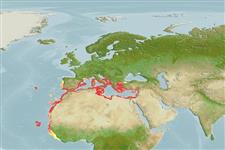Common names from other countries
>
Pleuronectiformes (Flatfishes) >
Bothidae (Lefteye flounders)
Etymology: Arnoglossus: Greek, aros, -oy = lamb + Greek, glossa = tongue (Ref. 45335).
Environment: milieu / climate zone / depth range / distribution range
Ökologie
seewasser demersal; tiefenbereich 15 - 300 m (Ref. 5979). Subtropical; 43°N - 6°N, 26°W - 42°E
Eastern Atlantic: Ireland (Ref. 4704) to Sierra Leone and Cape Verde. Also known from the western Mediterranean and Black Sea.
Length at first maturity / Size / Gewicht / Alter
Maturity: Lm 8.8, range 12 - ? cm
Max length : 18.0 cm SL Männchen/unbestimmt; (Ref. 4704); common length : 12.0 cm TL Männchen/unbestimmt; (Ref. 3397); max. veröff. Alter: 10 Jahre (Ref. 32766)
Rückenflossenstacheln (insgesamt): 0; Rückenflossenweichstrahlen (insgesamt): 81-91; Afterflossenweichstrahlen: 61 - 69. Second ray of dorsal fin very long, with a conspicuous dark, fringed broad membrane. First 3 or 4 dorsal fin rays generally blackish in adults but only the elongate second ray is dark in immature fishes.
Found on the upper 100 m of the continental shelf. Feeds on small fishes and invertebrates (Ref. 4704). Minimum depth reported taken from Ref. 52678 but has been caught in depths inferior to 10m (Ref. 57407).
Aldebert, Y., M. Desoutter and J.-C. Quéro, 1990. Bothidae. p. 1027-1036. In J.C. Quero, J.C. Hureau, C. Karrer, A. Post and L. Saldanha (eds.) Check-list of the fishes of the eastern tropical Atlantic (CLOFETA). JNICT, Lisbon; SEI, Paris; and UNESCO, Paris. Vol. 2. (Ref. 5979)
IUCN Rote Liste Status (Ref. 130435)
CITES (Ref. 128078)
Not Evaluated
Bedrohung für Menschen
Harmless
Nutzung durch Menschen
Fischereien: weniger kommerziell
Mehr Information
ReferenzenAquakulturAquakultur ProfilZuchtlinienGenetikElectrophoresesVererbbarkeitKrankheitenVerarbeitungMass conversion
Tools
Warning: mysqli::__construct(): (HY000/1040): Too many connections in /var/www/html/includes/speciessummary.lib.php on line 2414
Can't connect to MySQL database fbquizv2. Errorcode: Too many connections
